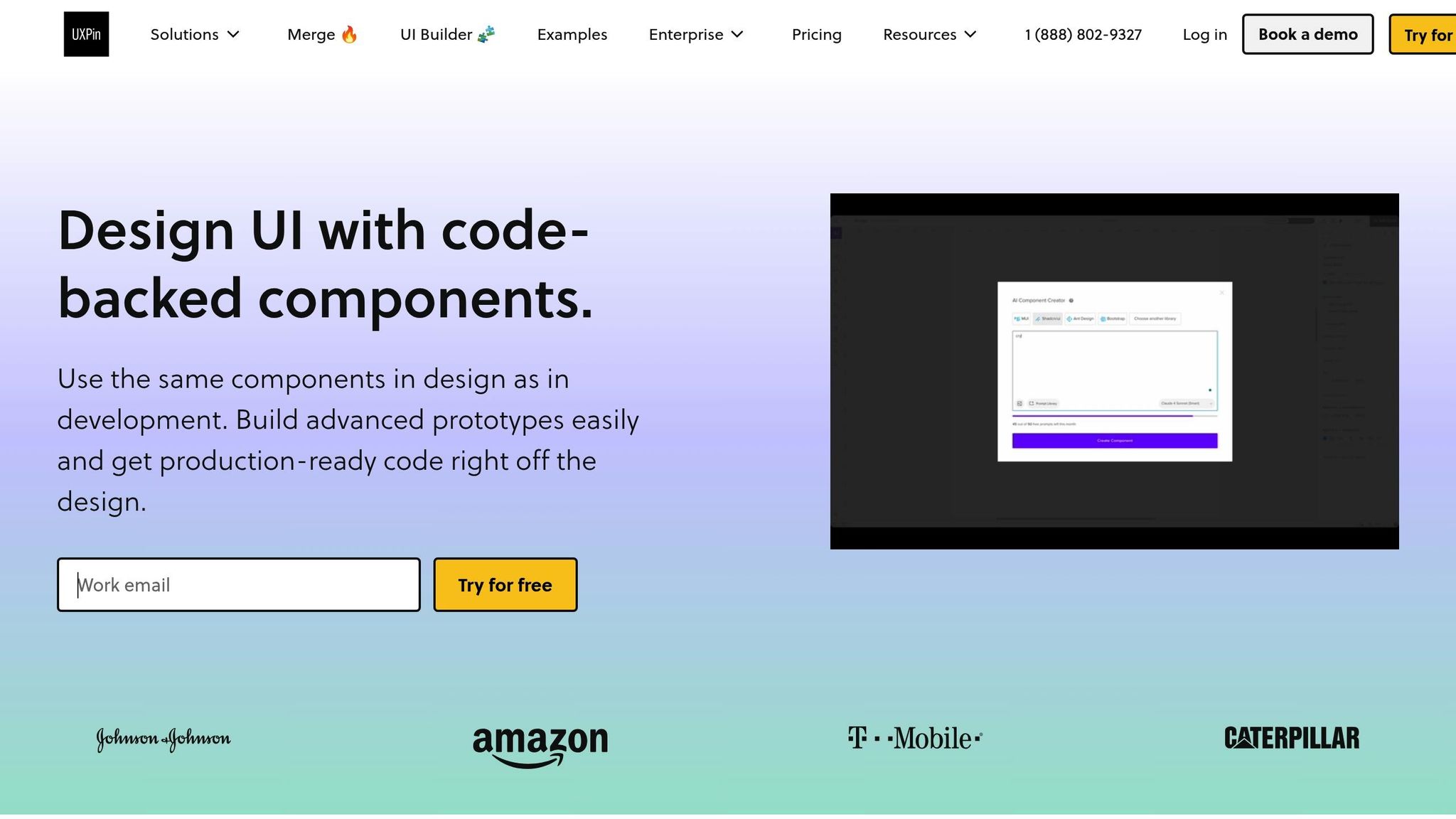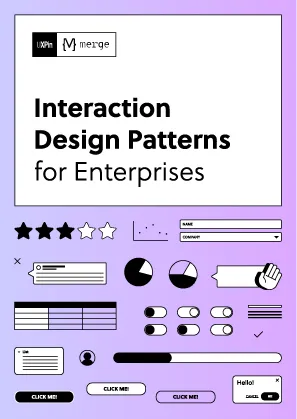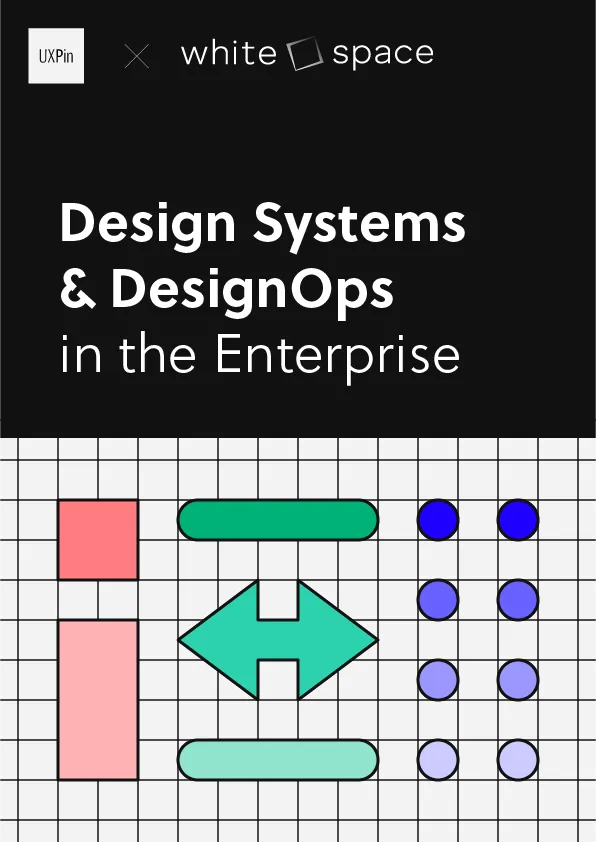The gap between design and development often slows down product creation. No-code automation tools solve this by directly converting design files into production-ready code, saving time, reducing errors, and improving team collaboration.
Key Points:
- Design-to-code means turning design files into functional code (HTML, CSS, JavaScript, etc.).
- Problems with manual workflows: Time-consuming handoffs, miscommunication, and mismatched versions.
- No-code automation benefits: Faster workflows, consistent results, and reduced manual effort.
- Tools like UXPin allow designers and developers to work in the same environment, using code-backed components for seamless collaboration.
By automating repetitive tasks, teams can focus on refining products instead of struggling with inefficient workflows. Platforms like UXPin streamline processes, improve accuracy, and cut development time significantly.
How No-Code Automation Solves Design-to-Code Problems
No-code automation platforms are changing the game when it comes to design-to-code workflows. These tools cut out the tedious manual steps that often bog down traditional processes. Instead of relying on time-intensive handoffs and manual coding, they create a direct pipeline from design concepts to production-ready code.
By automatically generating clean, maintainable code straight from design files, no-code platforms eliminate the need for manual recreation. This shift not only speeds up development but also ensures consistency and accuracy, setting the stage for smoother product development.
No-Code Platforms in Product Development
No-code platforms do more than just automate – they allow teams to focus on meaningful work instead of repetitive tasks. By addressing common design-to-code challenges, these tools streamline workflows and improve collaboration across teams. The result? Development timelines shrink significantly.
One standout feature is component mapping. These platforms link design elements directly to their corresponding code components, ensuring changes are applied consistently across the entire product. For instance, if a designer updates a button style, that update is automatically reflected everywhere the button appears in the codebase.
These platforms also handle quality checks, convert wireframes to fully functional prototypes, and tag design tokens – all automatically. This frees up designers and developers to focus on improving user experiences and creating robust architectures, rather than getting bogged down in manual translation tasks.
"When I used UXPin Merge, our engineering time was reduced by around 50%. Imagine how much money that saves across an enterprise-level organization with dozens of designers and hundreds of engineers." – Larry Sawyer, Lead UX Designer
Benefits of No-Code Automation
The real impact of no-code automation becomes clear when you look at real-world results. For example, in 2023, PayPal‘s product teams revamped their internal UI development process using interactive components. Tasks that used to take over an hour for experienced designers were completed in under 10 minutes. This shift allowed teams to allocate their time and resources more effectively.
Microsoft provides another example with its AI-powered Fluent Design System. This system automatically adjusts UI elements to match user preferences and device types, ensuring a seamless experience across the Microsoft ecosystem. By eliminating manual adjustments, Microsoft reduces inconsistencies and speeds up responsive design workflows.
Collaboration is another area where no-code platforms shine. By using the same code-backed components, designers and developers create a shared language that eliminates miscommunication. Conversations become more focused and actionable, leading to better outcomes.
"As a full stack design team, UXPin Merge is our primary tool when designing user experiences. We have integrated our custom-built React Design System and can design with our coded components. It has increased our productivity, quality, and consistency, streamlining our testing of layouts and the developer handoff process." – Brian Demchak, Sr. UX Designer at AAA Digital & Creative Services
Error reduction is a major advantage, especially in complex projects. No-code platforms generate production-ready code that aligns with coding standards and best practices, eliminating common human errors in syntax and structure. This consistency is invaluable for maintaining large design systems or managing projects across multiple teams.
The financial benefits are hard to ignore. When engineering time is cut by 50% or more, organizations with large teams of designers and engineers can save a significant amount of money. These savings grow over time, especially when you factor in fewer bug fixes, design revisions, and rework caused by manual errors.
Real-Time Collaboration Features That Fix Workflows
Traditional design-to-code workflows often feel disjointed. Designers work in one tool, developers in another, and feedback gets lost somewhere in between. No-code platforms with real-time collaboration features flip this script by creating shared spaces where everyone – designers, developers, and stakeholders – can work together at the same time.
These tools reshape team communication and iteration. Without real-time updates, delays and misunderstandings are almost inevitable. But with immediate interaction, those issues fade away, creating a smoother, more efficient workflow. This sets the stage for game-changing features like real-time editing and unified design systems.
Real-Time Editing and Feedback
Real-time editing allows teams to collaborate simultaneously without stepping on each other’s toes. For example, when a designer tweaks a component, developers can see the update instantly and understand how it impacts the codebase. This seamless interaction bridges the gap that often exists between design and development.
The feedback process also becomes much more streamlined. Stakeholders can review prototypes and leave comments directly on specific elements, skipping the endless back-and-forth of screenshots or external review tools. Everything happens in one place, in real time.
AI tools take this even further by tracking updates to components and style guides, flagging inconsistencies, and speeding up iterations. Teams using AI for version control and design tracking report fewer errors and faster progress. Think of it as a safety net, catching potential problems before they escalate into costly issues. This kind of automation helps teams move quickly while maintaining high-quality standards.
While real-time editing smooths collaboration, having a unified design system ensures everyone stays on the same page.
Single Source of Truth
Version control can be a nightmare in design-to-code workflows. No-code platforms solve this by making code the "single source of truth." Design elements are tied directly to their corresponding code components, so updates – like tweaking a button style – are automatically applied everywhere that component is used.
"Make code your single source of truth. Use one environment for all. Let designers and developers speak the same language." – UXPin
This unified approach eliminates the need for lengthy design specs and reduces errors caused by miscommunication. Designers and developers can finally speak the same "language", making collaboration much more intuitive.
The impact is clear in real-world examples. PayPal, for instance, revamped its internal UI development process by using interactive components. This change cut design tasks for experienced designers from over an hour to less than 10 minutes. The key? Removing the translation layer between design and code.
Centralizing design systems as a single source of truth brings consistency and efficiency to the forefront. Everyone works from the same foundation, ensuring visual and functional harmony across the board. Updates – like changes to color palettes or typography – flow through the entire system automatically, keeping brand consistency intact without the need for constant manual checks. It’s a win-win for speed and quality.
UXPin: A Solution for Design-to-Code Automation

UXPin addresses the challenges of design-to-code workflows by creating a unified platform where designers and developers collaborate using the same components. This approach eliminates the usual hurdles – delays, miscommunication, and inconsistencies – by allowing teams to build directly with code-backed elements.
What makes UXPin stand out is its focus on making code the backbone of the design process. By designing interfaces with actual React components, designers produce assets that align perfectly with the developer’s codebase. This streamlined integration ensures production-ready results, offering tangible benefits in prototyping, AI tools, and team collaboration.
Code-Backed Prototyping and Component Libraries
With UXPin’s code-backed prototyping, every design element is a live React component. This means prototypes not only look like the final product but also function authentically from the start. Interactions, animations, and behaviors are all true to life.
The platform supports popular coded libraries like MUI, Tailwind UI, and Ant Design, along with custom Git component repositories. Teams can seamlessly sync their existing design systems with UXPin, ensuring consistency between design and development workflows.
"When I used UXPin Merge, our engineering time was reduced by around 50%. Imagine how much money that saves across an enterprise-level organization with dozens of designers and hundreds of engineers." – Larry Sawyer, Lead UX Designer
This integration enables the creation of high-fidelity prototypes with advanced interactions, variables, and conditional logic. Designers can also export production-ready React code and detailed specifications, minimizing handoff issues and saving valuable development time.
AI-Powered Tools and Reusable Components
UXPin’s AI Component Creator uses advanced AI models to generate code-backed layouts from simple prompts. Need a data table or a complex form? This tool can quickly prototype elements using your existing component library, speeding up the process while keeping everything aligned with your design system.
The platform also features a reusable component system, allowing teams to build a library of pre-documented, ready-to-use elements. Designers can assemble interfaces by combining these components without writing any code, while developers gain a clear understanding of the components they’ll be working with. Updates made to any component automatically apply across all designs, ensuring consistency and reducing manual upkeep.
Collaboration and Workflow Integration
UXPin redefines team collaboration by eliminating the need for traditional handoffs. Instead of passing static files back and forth, everyone works in the same environment using identical components. This shared setup minimizes miscommunication and keeps projects on track.
The platform integrates seamlessly with tools like Jira, Storybook, Slack, and GitHub. These integrations ensure that design updates sync directly with project management systems, giving developers immediate access to the latest specifications without switching between apps. Version history tracking also lets teams review changes and revert if necessary.
Real-time collaboration features make it easy for stakeholders to review prototypes and provide feedback directly on specific elements. Comments and suggestions appear instantly for all team members, eliminating the need for lengthy email chains or external review tools. This keeps everyone aligned and ensures projects move forward efficiently.
sbb-itb-f6354c6
Pros and Cons of No-Code Automation
No-code automation offers a mix of opportunities and challenges, particularly when addressing the hurdles of design-to-code workflows. It introduces significant efficiency gains but also requires thoughtful implementation to fully realize its potential.
Benefits of No-Code Design-to-Code Automation
Time Savings
One of the standout advantages is the dramatic reduction in time spent on tasks, cutting workflows from over an hour to under 10 minutes.
Consistency and Quality
Automated UI adjustments ensure design execution remains consistent and polished.
Better Collaboration and Fewer Errors
Shared component libraries and real-time feedback streamline teamwork and reduce the chance of errors.
Refocused Developer Efforts
By automating repetitive tasks, developers can shift their attention to solving complex problems and refining business logic, which enhances both product quality and job satisfaction.
| Aspect | Traditional Workflow | No-Code Automation |
|---|---|---|
| Delivery Speed | Slower, manual handoffs | Faster, automated code generation |
| Consistency | Prone to errors | High, with code-backed components |
| Collaboration | Siloed, prone to miscommunication | Unified, with real-time editing and feedback |
| Error Rate | Higher, manual coding risks | Lower, with automated quality checks |
| Developer Role | Manual, repetitive tasks | Focus on complex logic and refinement |
While these benefits are compelling, teams must also tackle several challenges to make the most of no-code automation.
Drawbacks and How to Address Them
Learning Curve
Designers need to familiarize themselves with code-backed components, while developers must adapt to new collaboration workflows.
Solution: Offer robust training programs and start with small pilot projects to build confidence before scaling up.
Complex Initial Setup
Establishing component libraries, design systems, and integration workflows can be daunting initially.
Solution: Start with prebuilt component libraries to deliver quick wins while gradually developing custom standards.
Dependence on Design Organization
Poorly structured design files can lead to subpar code output.
Solution: Create detailed design system guidelines and conduct regular audits to ensure consistency and quality.
Ongoing Maintenance
Design systems and component libraries require regular updates to remain effective.
Solution: Assign team members to maintain these systems and schedule periodic reviews to keep workflows optimized.
Integration Challenges
Integrating no-code tools with existing systems and legacy workflows can be tricky.
Solution: Map out your current workflows to identify integration points early, and choose platforms with strong API support to minimize disruptions.
Misconceptions About Developer Roles
Some may worry that automation replaces developers, which can create resistance.
Solution: Emphasize that automation is designed to handle routine tasks, freeing developers to focus on more complex and creative problem-solving. Involve them in selecting and implementing tools to ensure buy-in.
Conclusion: Improving Design-to-Code with No-Code Automation
Shifting from manual workflows to no-code automation brings major improvements in efficiency, consistency, and teamwork. As discussed earlier, tools like these streamline processes, allowing teams to achieve impressive outcomes. Take PayPal, for example – by adopting automated design-to-code workflows, they significantly cut down task completion times. This shift not only saves time but also allows teams to focus on solving complex challenges instead of getting bogged down by manual handoffs. Platforms like UXPin are perfectly positioned to help teams unlock these advantages.
UXPin stands out by addressing these challenges through its code-backed prototyping and AI-driven automation. By using the same React components for both design and development, it establishes a single source of truth, effectively minimizing inconsistencies and reducing the risk of design drift.
The real key to success is how you implement these tools. Start small with pilot projects to build confidence within your team. Make sure to set clear design system guidelines and choose platforms that offer robust component libraries and seamless integration. The goal here isn’t to replace creativity but to eliminate repetitive tasks, giving your team more time to innovate and create.
For teams still relying on manual processes, the pressing question isn’t whether to adopt no-code automation – it’s how soon they can make it work effectively. Platforms like UXPin lay the groundwork for faster iterations, improved consistency, and products that better align with user needs.
FAQs
How does no-code automation enhance collaboration between designers and developers?
No-code automation makes teamwork smoother by letting designers and developers use the same set of components. This approach helps maintain consistency across projects and minimizes miscommunication. The result? Clearer collaboration and a faster product development cycle.
These platforms break down the wall between design and code, allowing teams to concentrate on crafting excellent user experiences without being held back by technical hurdles.
What challenges might arise with no-code automation in design-to-code workflows, and how can they be resolved?
One of the biggest hurdles in no-code automation for design-to-code workflows is keeping designs and development aligned. When design tools and development platforms don’t work well together, the handoff process can become clunky, leading to mistakes and wasted time.
A practical way to tackle this issue is by using platforms that support designing with code. These tools allow teams to work with reusable components and code-powered prototypes, ensuring that designs are precise and development-ready. Features like real-time collaboration also make it easier for designers and developers to stay on the same page, smoothing out the entire workflow.
How does UXPin help speed up the design-to-code process and minimize errors?
UXPin makes the design-to-code process smoother by allowing teams to build interactive prototypes that are powered by real code. This approach ensures that designs are not only visually precise but also functional, minimizing potential errors when passing work to developers.
With tools like one-click code export and real-time collaboration, UXPin bridges the gap between designers and developers. By improving communication and cutting down on back-and-forths, it helps teams save time and work more efficiently during product development.

